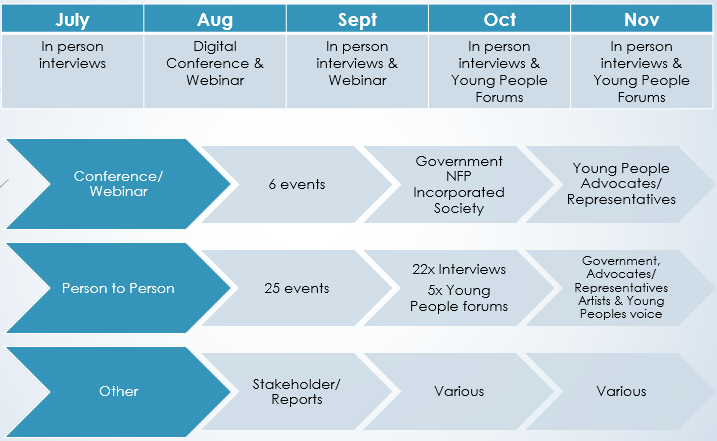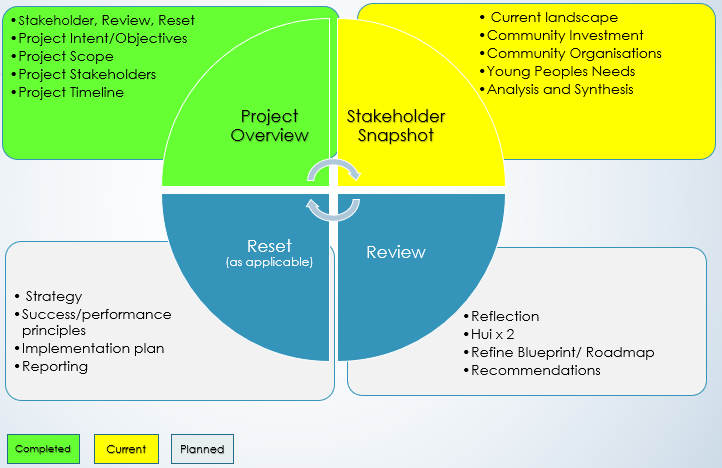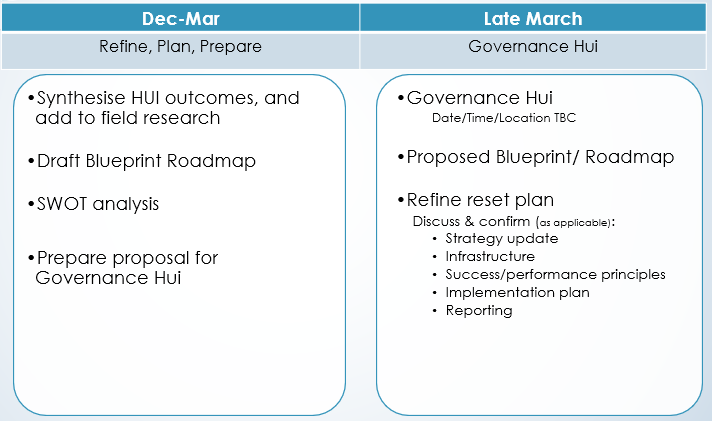Executive Summary
The impacts of the global COVID-19 pandemic, social inequalities, and racism on New Zealand identify the change in needs of young people from refugee and migrant environments. Mixit is a community development project committed to supporting youth affected by the ongoing situation. This report addresses the research funders, Mixit’s external stakeholders within the sector, and the government interested in the current landscape of Mixit’s programs. It provides some insight into the current climate in the youth context and suggests future steps for the Mixit project to better serve young people.
The research findings are based on the information gathered through in-person interviews, focus groups, Mixit huis, workshops, webinars, digital conferences, and Young People forums. Current societal changes lead to young people’s disruption resulting in a rapid rise of social and economic deprivation and isolation. Moreover, the needs are found outside of Auckland, and support should be provided at the national level. The pandemic aggravates the existing inequalities, and young people are likely to face additional pressure in 2021. At the same time, the current challenges can become an opportunity for Mixit to evolve and expand other organizations’ involvement and for youth to cooperate and contribute to post-disaster recovery. The core program is confirmed relevant to serving young people’s needs; however, there is a need for developing networking activities to contribute to the outreach program.
Six C’s Framework was designed highlighting the six areas for the organization to focus on:
- Cohort;
- Communications;
- Connection and Collaboration;
- Culture of Confidence;
- Consistency;
- Contribution
Introduction
Background
Mixit is a community development project based in Auckland, New Zealand, that supports young people from former refugee and migrant backgrounds. It aims to bring together youth with different experiences and engage them in creative activities. According to Mahony et al. (2017), “the economic, social and cultural rights (ESCR)” in NZ largely depend on volunteers and NGOs due to an insufficient legal framework (p. 5). Mixit was established in 2006 following the initial research into refugee youth’s needs and ways to help them with successful integration into new communities (“About,” n.d.). Founded in 2012, The Mixit Charitable trust assists young people at the community level and guides the project’s vision.
The new environment where humankind finds itself due to the COVID-19 pandemic, social issues, and racial injustices is significantly affecting young people at psychological, social, economic, and educational levels. The needs of former refugee and migrant youth are changing, which requires assessing the value, impact, and reach of Mixit programs. Currently, refugee quota intake has been on hold due to the COVID-19 response after an increase from 1,000 to 1,500 in July 2020 (Bellamy, 2020). According to Webb et al. (2020), disasters disproportionately affect young people’s developmental stages putting their well-being at risk. A constantly altering environment requires Mixit to adapt and ensure that the needs of young people from refugee and migrant backgrounds are met sustainably.
Purpose
Mixit is committed to remaining relevant and supporting the young people affected by the ongoing situation. Hence, the Mixit Research project identifies where refugee and migrant youth requirements are met, indicates the gaps, and outlines how organizations are responding. The program delivery needs to be reviewed and recalibrated in accordance with the altered environment and goals. This report addresses the research funders, Mixit’s external stakeholders within the sector, and the government interested in the current landscape of Mixit’s programs. This report aims to present the findings of the scoping research on the changing needs of refugee and migrant youth in NZ, as well as identify which gaps are filled and which leave much to be desired.
Methodology
A qualitative method was applied to create this report; in particular, interviews with internal and external stakeholders, as well as potential strategic partners, were conducted to collect data relevant to the Mixit Research. The key findings of Mixit huis, workshops, webinars, digital conferences, and Young People forums were synthesized, analyzed, and presented in a comprehensive report.
Data Collection & Points for Consideration
In-person interviews, webinars, forums, and focus groups were used to gather information from individuals involved in resolving issues that youth from refugee backgrounds faces. The contributions of different events are presented in Figure 1. Semi-structured and unstructured interviews and discussions with stakeholders allowed for gathering a snapshot of the current landscape and gaining insights regarding the subject and future outcomes.

Note. The wide-ranging activities and events provided numerous insights into young people’s needs and associated challenges for Mixit.
Findings
Current Landscape
In 2019 Mixit had commenced developing National Outreach programs and established workshops, consultations, and new partnerships in Hamilton and Christchurch, with plans to expand into other regions where refugee resettlement was identified. As part of this strategic development, it also introduced a new staff position of Outreach Coordinator. However, the global lockdown imposed additional risks on the youth and halted all the planned activities. Mixit recognizes the importance of stability and, thus, has adapted its program delivery in response to the COVID-19 pandemic. In 2020, Mixit continued to run activities online during Alert Level 4 concurrent with the Research, Review, Reset initiative. Furthermore, the national perspective became a part of our research phase, integrating the plans and activities for different regions. The Mixit Research project’s status is depicted in Figure 2.

Note. The framework highlights the Mixit Research project stages, offering an overview of the objectives and the recent progress.
The overview of the current landscape for Mixit can be presented as follows:
- it is unclear when the refugee quota will get reinstated;
- MIXIT’s reputation is strong;
- MIXIT’s programs and approach to using creativity as a vehicle remain relevant and in demand;
- lack of alignment is observed between government, community organizations, platforms, and pathways, for young people and their voice;
- young people’s needs haven’t changed but are highlighted even more due to the COVID-19 pandemic;
- extended consultations and lack of action are observed.
Needs of Young People
Current societal changes lead to young people’s disruption resulting in a rapid rise of social and economic deprivation and isolation. Their health and well-being are at significant risk, identifying the need for analysis of changing needs of youth from refugee and migrant backgrounds. Some old patterns and approaches to sector support are becoming irrelevant. Furthermore, structural changes are observed, and the communities are changing: large multi-ethnic African communities (often of Christian faith) have been replaced with diverse multi-ethnic Middle Eastern communities (often of Islamic faith). Hence, the needs and issues that Mixit faces are now very different.
As stated by the interview respondents, Mixit’s ability to create strong bonds and build continuing relationships makes it attractive to the target audience. Youth Forum in Auckland showed that young people appreciate Mixit for its positivity, enthusiasm, supportiveness, and new people they meet. As indicated in “Case study: Mixit Project” (n.d.), young adults feel connected, and their creativity not restrained by judgment becomes “a vehicle to empower“ (para. 8). Despite the struggles of 2020, Mixit researched and remained active on social media, maintaining positive engagement.
Through conversations, interviews, and discussions, several vital needs for youth from former refugee and migrant backgrounds were highlighted:
- young people are frustrated about being asked for their opinions and not seeing the outcomes of interviewing;
- reciprocity is crucial: young adults need to be valued and recognized for their contribution;
- the youth requires more creative activities apart from performing and opportunities for growth;
- the needs are found outside of Auckland, and support should be provided at the national level;
- the youth needs to be enabled to participate in decision-making and take on responsibilities to initiate and lead their projects;
- the gap in leadership skills development should be filled in;
- young people are willing to add value to other community organizations and their programs.
In terms of the COVID-19 situation, the following themes and trends can be outlined:
- the global pandemic exacerbated all the existing inequalities;
- significant transitions are required from the face-to-face to online learning;
- lack of devices, stable WiFi connection, quiet private space for studying or socializing increase the stress level and anxiety;
- online communication leaves out non-verbal social cues that many young people rely on;
- for isolated families, providing the information is challenging;
- for students doing the National Certificate of Educational Achievement (NCEA) COVID-19 outbreak disrupted their trajectory;
Opportunities and Challenges
The current situation implies both new opportunities and challenges for Mixit and young people. The main challenges and key opportunities to counter them are presented in Table 1.
Table 1. Key Challenges and Opportunities for Mixit.
Note. The Mixit Youth Forums in Auckland, Christchurch, Hamilton, and Wellington provide insight into the pressing issues that youth from refugee and migrant backgrounds face.
Six C’s Framework
As a result of a one-day forum with internal stakeholders (board members, staff, and volunteers) and clients (youth), the six areas for the organization to focus on in the future were recommended. Any gaps identified between ‘desired reality’ and ‘current state’ for each area will be explored further to determine what will be required to move forward (milestones and actions).
Cohort
This area of focus involves the Mixit team: Mixers (past and present) and staff. The research identified the need to:
- locate, connect with, mentor and empower, train and employ, retain a connection with Mixers, Youth Leaders, Young People, Young Adults, Alumni, Facilitators, and Staff;
- stay in touch and offer engaging opportunities (Mixit can consider R&D for new ideas and trial them in Auckland before taking them further);
- provide additional mentoring and develop some events beyond Saturday Programme;
- establish YL-led initiatives like Zoom weeknights;
- empower the Cohort by letting them help set the future, come up with new ideas, try them out, and involve them in project teams to support the future strategic plans and initiatives;
- grow the Cohort nationally in a deliberate way.
Communications
The majority of the forum participants highlighted the question to improve communications: ‘How Can We Be Famous?’ Some ideas include the need to:
- engage people and keep them connected;
- introduce Mixit storytelling: share all the good, the fun, the joy, the opportunities by using the voices of Mixers;
- let the Cohort help generate content;
- shout about the benefits and possibilities that Mixit offers;
- find more channels to communicate with refugees, migrants, their parents, and communities;
- follow-through, keep in touch after consultation, connection;
- share success stories with funders and government agencies;
- Develop a Communications Plan and Strategy that keeps stakeholders informed and connected.
Connection and Collaboration
This area of focus aims at connecting the dots and implementing an outreach strategy that requires Mixit to:
- establish a Stakeholder Database to enable effective and regular communications;
- ensure contact and communication, and collaborate with the Do’s
- including other refugee and migrant agencies, government, councils, funders, schools, ESOL, sports, and organizations;
- work together with collaborative partners to secure resources, funds and remove obstacles and barriers to participation;
- help to foster cross-sector communications.
Culture of Confidence
The application of the Mixit values at all times is critical to keep developing and enhancing the core program. There is a need to:
- ensure Mixit is a welcoming place: the newcomer is the most important person in the room;
- build confidence through arts and possibly extend to offer sport and other events;
- help the Cohort to grow and develop their confidence through activities, inclusion, empowerment, employment, mentoring, involvement in projects, storytelling, leadership opportunities;
- encourage more talking/communications/connection at Saturday sessions – “more than one word.”
Consistency
This focus area involves applying and adhering to the Mixit model for the core Auckland program and further outreach. It requires the following:
- a consistent application of values at all times, in all settings;
- the need to stretch it across Auckland and take it to a national level;
- the implementation of the core Mixit model;
- the need to find a way to protect Mixit IP;
- audit framework.
Contribution
This aspect refers to measuring Mixit’s contribution to a better Aotearoa, such as:
- measuring social and emotional impact, as well as economic impact (where possible);
- stronger communities;
- longitudinal studies.
Future Steps
Mixit recognizes the importance of prioritizing future actions, understanding dependencies and infrastructure requirements, and developing sub-projects and project teams to move some of these initiatives forward. Given the challenges, opportunities, and the need of young people identified by the Mixit Research, the project should focus on:
- mapping out a proposed blueprint with a set of initiatives and projects:
- operational initiatives;
- with more strategic oversight and governance (e.g., Mixit model distribution and ensuring an agreed level of consistency, the retention of IP, and so on);
- presenting the proposed blueprint to the Board;
- assigning resources, activating teams;
- To achieve its altered objectives, Mixit developed an outline of future steps (as presented in Figure 3).

Note. Synthesizing the HUI outcomes is the first step toward refining the plan and enhancing Mixit in accordance with the youth’s needs.
Conclusions
To summarize, significant gaps and inconsistent support between the top tiers of advocacy and policy and those working on the ground at the coalface with young people in the communities were identified. At the times of the global pandemic, the importance of mentoring and creating connections for young people and adults becomes even more relevant. Mixit strives to create a more inclusive society through implementing Outreach Programmes aimed at strong collaborations and improved communication nationwide.
In analyzing the interview and target groups data, two themes emerged which can be considered the crucial Mixit Research findings:
- the core program is confirmed to be relevant and valuable to serve the young people’s needs well;
- the need for developing networking activities to contribute to the outreach program is established.
Recommendations
Future Mission Statement
Mixit will invest and evolve to serve young people and enable social cohesion across Aotearoa.
High-Level Strategic Goals
- implement Outreach Programmes to improve opportunities for young people nationwide;
- establish strong collaborations with other organizations and agencies (i.e., DOC, Spirit of Adventure Trust, Outward Bound, RASNZ, Shama, NZRC, Red Cross, ROC, Ara Taiohi, Empower, and others);
- continue monitoring the changing needs of young people.
References
About. (n.d.). Mixit. Web.
Bellamy, P. (2020). The New Zealand Refugee Quota: A snapshot of recent trends.Parliamentary Library Research and Information. Web.
Case study: Mixit Project.(n.d.). Creative New Zealand. Web.
Mahony, C., Marlowe, J., Humpage, L., & Baird, N. (2017) Aspirational yet precarious: Compliance of New Zealand refugee settlement policy with international human rights obligations.International journal of migration and border studies, 3(1), 5-23. Web.
Webb, S., Kingstone, S., Richardson, E., & Flett, J. (2020). Rapid evidence brief: COVID-19 Youth Recovery Plan 2020-2022. Te Hiringa Hauora/Health Promotion Agency.